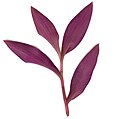Tradescantia pallida
| Tradescantia pallida | |
|---|---|

| |
| Tradescantia pallida 'Purpurea' | |
| Scientific classification | |
| Kingdom: | Plantae |
| Clade: | Tracheophytes |
| Clade: | Angiosperms |
| Clade: | Monocots |
| Clade: | Commelinids |
| Order: | Commelinales |
| Family: | Commelinaceae |
| Genus: | Tradescantia |
| Species: | T. pallida
|
| Binomial name | |
| Tradescantia pallida | |
| Synonyms[1] | |
|
Setcreasea pallida Rose | |
Tradescantia pallida is a species of spiderwort native to the Gulf Coast region of eastern Mexico. The cultivar T. pallida 'Purpurea' is commonly called purple secretia, purple-heart,[2] or purple queen.[3]
Taxonomy
[edit]T. pallida is a species of spiderwort in the family Commelinaceae.[4] The type specimen was collected by Edward Palmer, one of the main US plant collectors of his time, in the Mexican state of Tamaulipas (possibly near Ciudad Victoria[5]) in 1907.[6] The species was described by Joseph Nelson Rose in 1911. He placed it in the genus Setcreasea. In 1975 David Hunt transferred the species to the genus Tradescantia.[4] Hunt also treated Setcreasea purpurea as a cultivar of S. pallida.[5] The latter names are still often used to refer to T. pallida.[4] The specific epithet pallida means "pale", referring to the original color of the leaves.[6]
The plant is known by several common names, including purple heart (probably in reference to the eponymous military medal[6]) and purple wandering jew.[4]
Description
[edit]T. pallida is perennial and herbaceous. It has a rambling habit, with plants reaching about a 1 ft (0.30 m) in height but spreading considerably wider.[4] Wild specimens are gray-green-purplish with a washed out look.[6]
The fleshy, hairy leaves are up to 7 in (180 mm) long and form a sheath around fleshy stems, which break off easily. On the ends of the stems the plants produce relatively inconspicuous flowers. The flowering is most abundant from midsummer through fall and sporadic at other times of the year.[4] The flowers are open only in the morning.[6] The plants are evergreen,[6] but in colder areas die back to the ground in winter and resprout from the roots in spring.[4]
Distribution and habitat
[edit]T. pallida is found along the coast of the Gulf of Mexico. Its native range extends from Tamaulipas to Yucatan.[6] The species has been collected in a tropical deciduous forest, among roadside limestone rocks, and on limestone outcrops.[5]
Uses
[edit]T. pallida is grown as an ornamental plant for its attractive foliage.[4] Only the cultivar 'Purpurea', featuring purple-violet leaves and stems,[7] is commercially grown.[6] 'Purpurea' is sometimes sold under the name 'Purple Heart'.[7] It has gained the Royal Horticultural Society's Award of Garden Merit.[8]
As a houseplant, T. pallida has been judged exceptionally effective at improving indoor air quality by filtering out volatile organic compounds, a class of common pollutants and respiratory irritants, an effect known as phytoremediation.[9]
Gallery
[edit]-
Leaves, superior aspect
(T. pallida 'Purpurea') -
Leaves, inferior aspect
(T. pallida 'Purpurea') -
Flower
References
[edit]- ^ "Tradescantia pallida". Germplasm Resources Information Network. Agricultural Research Service, United States Department of Agriculture. Retrieved 2011-11-20.
- ^ BSBI List 2007 (xls). Botanical Society of Britain and Ireland. Archived from the original (xls) on 2015-06-26. Retrieved 2014-10-17.
- ^ USDA, NRCS (n.d.). "Tradescantia pallida". The PLANTS Database (plants.usda.gov). Greensboro, North Carolina: National Plant Data Team. Retrieved 14 December 2015.
- ^ a b c d e f g h Mahr, Susan. "Purple Heart, Tradescantia pallida". University of Wisconsin. Retrieved 29 September 2024.
- ^ a b c "The Reunion of Setcreasea and Separotheca with Tradescantia". American Commelinaceae: I. 30 (3). Kew Bulletin: 443–458. 1975. Retrieved 29 September 2024.
- ^ a b c d e f g h Klingaman, Gerald (21 October 2016). "Plant of the Week: Tradescantia pallida, Purple Heart". University of Arkansas. Retrieved 29 September 2024.
- ^ a b "Tradescantia pallida 'Purpurea'". Missouri Botanical Garden. Retrieved 29 September 2024.
- ^ "Tradescantia pallida 'Purpurea'". RHS. Retrieved 5 March 2021.
- ^ Yang, Dong Sik; Pennisi, Svoboda V.; Son, Ki-Cheol; Kays, Stanley J. (1 August 2009). "Screening Indoor Plants for Volatile Organic Pollutant Removal Efficiency". HortScience. 44 (5): 1377–1381.
External links
[edit] Media related to Tradescantia pallida at Wikimedia Commons
Media related to Tradescantia pallida at Wikimedia Commons Data related to Tradescantia pallida at Wikispecies
Data related to Tradescantia pallida at Wikispecies



